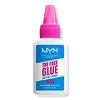What's inside
What's inside
 Key Ingredients
Key Ingredients

 Benefits
Benefits

 Concerns
Concerns

No concerns
 Ingredients Side-by-side
Ingredients Side-by-side

Water
Skin ConditioningCyclopentasiloxane
EmollientMethyl Methacrylate Crosspolymer
Cyclohexasiloxane
EmollientButylene Glycol
HumectantPEG-10 Dimethicone
Skin ConditioningTrimethylsiloxysilicate
EmollientPolyglyceryl-3 Polydimethylsiloxyethyl Dimethicone
Skin ConditioningSilica Dimethyl Silylate
EmollientSodium Chloride
MaskingTriethoxycaprylylsilane
Dimethicone
EmollientDimethicone/Vinyl Dimethicone Crosspolymer
Skin ConditioningAluminum Hydroxide
EmollientDisodium EDTA
Propylene Carbonate
SolventDisteardimonium Hectorite
StabilisingEthylhexylglycerin
Skin ConditioningCetyl PEG/PPG-10/1 Dimethicone
EmulsifyingTocopherol
AntioxidantPentaerythrityl Tetra-Di-T-Butyl Hydroxyhydrocinnamate
AntioxidantPhenoxyethanol
PreservativeIron Oxides
CI 77891
Cosmetic ColorantWater, Cyclopentasiloxane, Methyl Methacrylate Crosspolymer, Cyclohexasiloxane, Butylene Glycol, PEG-10 Dimethicone, Trimethylsiloxysilicate, Polyglyceryl-3 Polydimethylsiloxyethyl Dimethicone, Silica Dimethyl Silylate, Sodium Chloride, Triethoxycaprylylsilane, Dimethicone, Dimethicone/Vinyl Dimethicone Crosspolymer, Aluminum Hydroxide, Disodium EDTA, Propylene Carbonate, Disteardimonium Hectorite, Ethylhexylglycerin, Cetyl PEG/PPG-10/1 Dimethicone, Tocopherol, Pentaerythrityl Tetra-Di-T-Butyl Hydroxyhydrocinnamate, Phenoxyethanol, Iron Oxides, CI 77891
Water
Skin ConditioningGlycerin
HumectantPEG-150 Distearate
EmulsifyingButylene Glycol
HumectantPvp
Emulsion StabilisingOpuntia Ficus-Indica Stem Extract
Skin ConditioningAcer Saccharum Extract
Skin ConditioningPotassium PCA
HumectantCarbomer
Emulsion StabilisingIsododecane
EmollientSodium Hyaluronate
HumectantTromethamine
BufferingAluminum Hydroxide
EmollientMagnesium PCA
HumectantIsopropyl Titanium Triisostearate
EmollientHydroxypropyltrimonium Hyaluronate
Caprylyl Glycol
EmollientTrisodium Ethylenediamine Disuccinate
Xanthan Gum
EmulsifyingPanthenol
Skin ConditioningEthylhexylglycerin
Skin ConditioningPolyglutamic Acid
Skin ConditioningPolyglyceryl-4 Isostearate
EmulsifyingOctyldodecanol
EmollientTocopherol
AntioxidantAscorbyl Palmitate
AntioxidantPotassium Sorbate
PreservativePhenoxyethanol
PreservativeCI 77891
Cosmetic ColorantWater, Glycerin, PEG-150 Distearate, Butylene Glycol, Pvp, Opuntia Ficus-Indica Stem Extract, Acer Saccharum Extract, Potassium PCA, Carbomer, Isododecane, Sodium Hyaluronate, Tromethamine, Aluminum Hydroxide, Magnesium PCA, Isopropyl Titanium Triisostearate, Hydroxypropyltrimonium Hyaluronate, Caprylyl Glycol, Trisodium Ethylenediamine Disuccinate, Xanthan Gum, Panthenol, Ethylhexylglycerin, Polyglutamic Acid, Polyglyceryl-4 Isostearate, Octyldodecanol, Tocopherol, Ascorbyl Palmitate, Potassium Sorbate, Phenoxyethanol, CI 77891
 Reviews
Reviews

Ingredients Explained
These ingredients are found in both products.
Ingredients higher up in an ingredient list are typically present in a larger amount.
Aluminum Hydroxide is a form of aluminum. It can be naturally found in nature as the mineral gibbsite. In cosmetics, Aluminum Hydroxide is used as a colorant, pH adjuster, and absorbent.
As a colorant, Aluminum Hydroxide may add opacity, or reduce the transparency. Aluminum hydroxide is contains both basic and acidic properties.
According to manufacturers, this ingredient is an emollient and humectant. This means it helps hydrate the skin.
In medicine, this ingredient is used to help relieve heartburn and help heal ulcers.
There is currently no credible scientific evidence linking aluminum hydroxide in cosmetics to increased cancer risk.
Major health organizations allow the use of aluminum hydroxide in personal care products and have not flagged it as a carcinogenic risk at typical usage levels.
Learn more about Aluminum HydroxideButylene Glycol (or BG) is used within cosmetic products for a few different reasons:
Overall, Butylene Glycol is a safe and well-rounded ingredient that works well with other ingredients.
Though this ingredient works well with most skin types, some people with sensitive skin may experience a reaction such as allergic rashes, closed comedones, or itchiness.
Learn more about Butylene GlycolCi 77891 is a white pigment from Titanium dioxide. It is naturally found in minerals such as rutile and ilmenite.
It's main function is to add a white color to cosmetics. It can also be mixed with other colors to create different shades.
Ci 77891 is commonly found in sunscreens due to its ability to block UV rays.
Learn more about CI 77891Ethylhexylglycerin (we can't pronounce this either) is commonly used as a preservative and skin softener. It is derived from glyceryl.
You might see Ethylhexylglycerin often paired with other preservatives such as phenoxyethanol. Ethylhexylglycerin has been found to increase the effectiveness of these other preservatives.
Phenoxyethanol is a preservative that has germicide, antimicrobial, and aromatic properties. Studies show that phenoxyethanol can prevent microbial growth. By itself, it has a scent that is similar to that of a rose.
It's often used in formulations along with Caprylyl Glycol to preserve the shelf life of products.
Tocopherol (also known as Vitamin E) is a common antioxidant used to help protect the skin from free-radicals and strengthen the skin barrier. It's also fat soluble - this means our skin is great at absorbing it.
Vitamin E also helps keep your natural skin lipids healthy. Your lipid skin barrier naturally consists of lipids, ceramides, and fatty acids. Vitamin E offers extra protection for your skin’s lipid barrier, keeping your skin healthy and nourished.
Another benefit is a bit of UV protection. Vitamin E helps reduce the damage caused by UVB rays. (It should not replace your sunscreen). Combining it with Vitamin C can decrease sunburned cells and hyperpigmentation after UV exposure.
You might have noticed Vitamin E + C often paired together. This is because it is great at stabilizing Vitamin C. Using the two together helps increase the effectiveness of both ingredients.
There are often claims that Vitamin E can reduce/prevent scarring, but these claims haven't been confirmed by scientific research.
Learn more about TocopherolWater. It's the most common cosmetic ingredient of all. You'll usually see it at the top of ingredient lists, meaning that it makes up the largest part of the product.
So why is it so popular? Water most often acts as a solvent - this means that it helps dissolve other ingredients into the formulation.
You'll also recognize water as that liquid we all need to stay alive. If you see this, drink a glass of water. Stay hydrated!
Learn more about Water